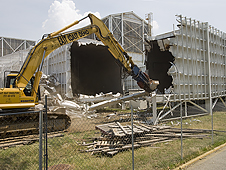- NASA Home
- | Centers
- | Langley Home
- | Langley News
- | Researcher News
Search Langley
Feature
Wind Tunnel Workers Watch Sadly as 7X10 Disappears
06.25.08
Like a long-necked, yellow carnivore, the crane lunges forward. Its jaws take another bite of metal, and then the crane pulls back so that the jaws can drop their load into a truck.
A bit of history is disappearing before the face of progress and the reality of NASA Langley's budget. Since it went into operation in 1945, the 7- by-10-Foot High Speed tunnel at NASA Langley has tested models of the nascent version of the Bell X-5 -- the world's first airplane to vary the sweep of its wings while in flight -- and of some of the nation's most renowned military attack aircraft.
Now it is going away.
"It's a sad occurrence," says Frank Quinto, who oversees work at the 14-by-22-Foot Subsonic tunnel next door. "Any time one goes away is a sad day for a wind tunnel man."

7-by10-foot High Speed Wind Tunnel, built in 1945, was used in the development of many of NASA's most famous projects, including the X-15 and Mercury programs. Credit: NASA/Sean Smith
There's more sadness to come. Next fiscal year, the 16-Foot Transonic tunnel is going to join the 7-by-10 in the archives. So are two 8-Foot tunnels.
The year after that, the 30-by-60-Foot Full-Scale tunnel on Langley's East Side is scheduled to go. Its "deconstruction" awaits only the release of already-approved funding in Fiscal Year '09.
In each case, work that had been done in the tunnels was absorbed elsewhere. And in each case, decreasing demand for wind tunnel testing meant increased costs for the tunnels themselves.
A tunnel in hiatus can be reactivated in six to 12 months, but that hiatus is costly. Langley has spent millions of dollars in keeping the inactive wind tunnels around.
The 7-by-10 tunnel is the first to go. Its history is vivid.
In 1946, a "transonic bump" was installed in the 7-by-10, enabling air to pass through at up to the speed of sound: 761 mph at sea level. The A-6 Intruder was tested there, as were the EA-6B Prowler and F-111 Aardvark. Before the 7-by-10 was closed in 1993, parts of the F-18 Hornet were tested there.
After it was closed to testing, the 7-by-10 was used to show visitors how wind tunnels work, taking some of the pressure off other Langley facilities.
"Any time visitors come to a wind tunnel, there is some disruption to the operations," said Quinto, "So it was decided to open the 7-by-10 to visitors. I used to lead tours there of from five to 40 people. I had Congressmen, staffers, youth groups."
With heightened security in the aftermath of the terrorist attacks of Sept. 11, 2001, much of that ended.
So now the crane does its work, from the outside-in so as to keep down dust from asbestos and lead paint that has been covered over by layers of paint for years.
And ahead lies more "deconstruction," a word that is drawn from the recycling that will be done with much of the debris.
The 16-foot Transonic tunnel was scheduled to go about four years ago, and the two 8-Foot tunnels have been inactive for decades. One of them, the 8-Foot Transonic Pressure tunnel, is a national landmark, in large part because of the work aviation pioneer Dick Whitcomb did there. Whitcomb's discovery of the "area rule" enabled supersonic flight and earned him the prestigious Collier Trophy in 1954.
The Full-Scale tunnel has been run by Old Dominion University for several years, but ODU's lease on the facility is scheduled to run out.
"We've tried to get somebody to take over funding," said Cheryl Allen, who is overseeing the deconstruction program for the Center Operations Directorate, "but the cost to operate and maintain the facility is just too high."
And so it will go, like the others.
And "wind tunnel guys" will remember what went on in those facilities as witnesses to history. "It's like in the Navy," Quinto said. "When they towed out the USS America and sank her (in 2005, off the North Carolina coast), everybody who had served on her was sad about it."
NASA Langley Research Center
Managing Editor: Jim Hodges
Executive Editor and Responsible NASA Official: H. Keith Henry
Editor and Curator: Denise Adams